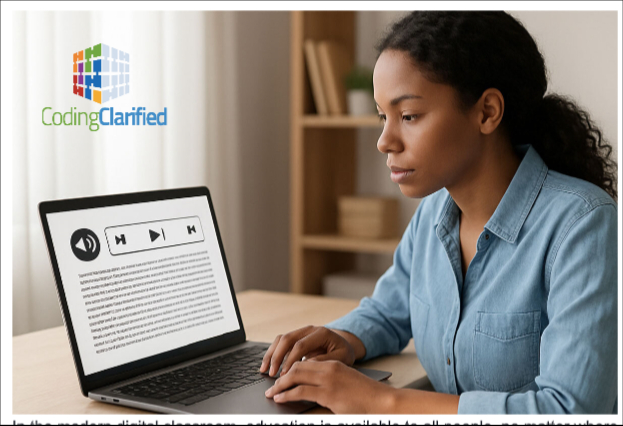In the modern digital classroom, education is available to all people, no matter where they come from or what they can do. For most students, the text-based form of digital learning content can present a frustrating and usually insurmountable obstacle. By boosting accessibility with text to speech API technology, a learning platform can effectively break this issue. It’s an essential tool for creating an inclusive learning space in which all students, from those with learning disabilities to those who are blind or have low vision, can fully access and master the material. This is why text-to-speech should be in every learning platform.
Let’s discuss the other strong reasons why text-to-speech must be a part of every learning system.
Reasons Text-to-Speech Should Be in Every Learning Platform
- It Enhances Comprehension and Retention for All
While necessary for access, text-to-speech API technology is a valuable tool for multimodal learning that benefits all students. By using both the visual and auditory senses, a student is able to learn information better. This two-input strategy consolidates neural pathways, which greatly enhances their capacity for recalling and comprehending new information.
When a learning platform utilizes a high-quality TTS engine to recite material, it supports all learning styles, particularly auditory learners who learn best by hearing. For a student learning a tough subject, being able to read and listen to the same material at the same time reinforces the material and makes their memory stronger, making it a very effective study technique. It is not merely a few’s accommodation; it’s a tried and tested approach to enhance the learning outcomes for everyone.
- It’s a Game-Changer for Language Learning
For students acquiring a new language, TTS is a valuable tool. It presents a clear, consistent, and accurate model of pronunciation, enabling learners to hear how words and sentences are produced by a native-like voice. This is important for the acquisition of proper speaking and listening skills.
For instance, a learner can practice his or her rhythm and accent by mimicking the TTS voice. In addition to pronunciation, TTS can assist non-native speakers in reading fluency and comprehension. When confronted with a dense piece of writing, a student can hear the content of their target language, allowing them to concentrate on deciphering its meaning without being slowed down by an awkward vocabulary or convoluted grammar. They can hear the text repeated as often as they wish and even set the speed of playback to suit their own rate of learning.
- It Increases Engagement and Student Satisfaction
An accessible learning platform that offers support for various learning styles is more likely to engage and retain students. If learners perceive that the platform has been developed with their needs in consideration, they are more likely to enjoy a positive and productive learning experience.
Improved student satisfaction can result in improved course completion rates and more favorable feedback.
In a competitive market, an inclusive platform that offers a superior user experience will distinguish itself and draw a broader, more diverse group of users. By offering a genuinely inclusive toolset, you not only enhance student achievement but also establish yourself as an innovative, forward-thinking education company, which can translate to increased enrollment and brand loyalty.
- It Offers Unparalleled Flexibility and Convenience
These days, students have hectic, active lifestyles, and they require study aids capable of matching their pace. TTS technology enables them to listen to course content whenever and wherever they wish, without being bound to a screen. A student is able to listen to classes, read posts, or study notes during a bus commute, while working out at the gym, or while doing housework, turning wasted time into valuable learning time.
Additionally, TTS prevents digital fatigue. After hours of screen time staring at a computer for research or writing, the ability to shut their eyes and just listen to the content is a welcome relief. This encourages a healthier and more sustainable study practice, allowing students to stay focused for longer stretches without the irritation of eye strain. This adaptability also simplifies revision work, as students can easily replay important passages to refresh their memory without having to go back to their desks.
- It Provides Scalability and Affordability
Prior to the advent of contemporary AI voices, it was challenging and costly to add audio content to a learning environment. It involved recruiting professional voice actors, hiring a studio, and investing in hours of editing and production. This rendered adding audio a luxury that was beyond the reach of most small educational institutions and content creators.
But thanks to modern-day TTS technology, producing high-quality audio is both quick and extremely cheap. A platform can now record libraries of textbooks, articles, and lectures into audio at a mere fraction of the cost traditionally required, enabling them to grow their content creation on a shoestring budget. This affordability makes the production of rich, audio-based content democratised for platforms of every size.
The Bottom Line
Ultimately, the integration of text-to-speech technology is a requisite adaptation for all contemporary learning platforms. It is an incredibly valuable tool that not only ensures education for students with visual and reading disabilities but also makes learning engaging for everyone.
So, if you are developing a learning platform, consider integrating a text-to-speech API to make learning accessible, inclusive, and fun.
Coding Clarified uses this feature in our course. https://codingclarified.com/mastering-online-medical-coding-training/

